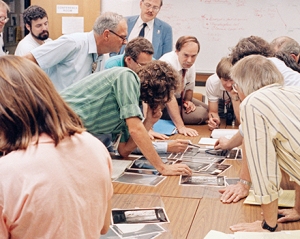Aug 26 2014
August 25, 1989: Neptune is in view. It is the middle of the night and everything is happening fast at NASA's Jet Propulsion Laboratory in Pasadena, California. Voyager team members have had little or no sleep. Vice President Dan Quayle is on the scene and Chuck Berry, of "Johnny B. Goode" fame, is prepping for an outdoor party. This will be "the last picture show" of the grand tour of the solar system by NASA's Voyager mission.
 Members of the Voyager science team pore over fresh images of Neptune's moon Triton as data from Voyager 2 stream into JPL in August 1989. Image credit: NASA/JPL-Caltech
Members of the Voyager science team pore over fresh images of Neptune's moon Triton as data from Voyager 2 stream into JPL in August 1989. Image credit: NASA/JPL-Caltech
Fast forward to August 25, 2014: New Horizons, the first mission sent to explore dwarf planet Pluto and other icy objects within the Kuiper Belt, is less than one year away from its arrival. And today, New Horizons will cross Neptune's orbit -- the very day that Voyager 2 flew past Neptune 25 years ago.
In celebration of this anniversary, scientists from both missions reflected on Voyager 2's Neptune encounter.
The Encounter -- Coming in Close
The Voyager team remembers how extraordinary it was to visit Neptune.
"We had been lucky enough to be in the right place at the right time with the right team, and this was the first and only opportunity we would have for a long time for an up-close and personal view with Neptune and the outer parts of our solar system," said Ralph McNutt, a member of the New Horizons science team who was a plasma data team member on Voyager 2.
New Horizons Principal Investigator Alan Stern, now based at the Southwest Research Institute in Boulder, was a graduate student at the University of Colorado, Boulder, at the time of the encounter.
"As much as anything, just seeing this world unfold from the point of light it had been to become a real place was just enthralling," Stern said.
The Exhilaration at JPL
JPL, which manages the Voyager mission, was an exciting place to be in 1989.
Tom Spilker, who was a member of the Voyager 2 radio science team and who has since moved on from JPL, recalls: "I got this overwhelming feeling inside, as if I was standing in the bow of Captain Cook's expedition into the Gulf of Alaska for the very first time. We were going to places where no one had ever gone before -- we were explorers."
Stern describes JPL as the place where "all the action was" in August of 1989.
"I do remember Carl Sagan calling me at the Goddard Space Flight Center, while I was making collaborative measurements of Neptune's moon Triton with the International Ultraviolet Explorer satellite to say, 'Hey, you're not in the thick of it, but let me tell you what the press doesn't know yet.' He did this so I would feel like an insider," Stern said.
Discoveries
As the spacecraft delivered images of Neptune, scientists uncovered some unexpected findings.
"The Voyager 2 flyby of Neptune was just another example of the surprises we had time after time as Voyager was flying by each of the outer planets," said Ed Stone, project scientist for Voyager at the California Institute of Technology in Pasadena.
The "Great Dark Spot" on Neptune was the first big surprise.
"This dark spot is very similar to the Great Red Spot on our solar system's largest planet, Jupiter, which is a very large storm," Stone said. Because Neptune is six times farther from the sun than Jupiter, it receives a fraction of the energy that Jupiter does -- this dark spot was a complete surprise.
Voyager scientists were also amazed to see that Triton, a moon of Neptune, has active geysers.
"The Triton flyby was my favorite moment partly because it was a bookend. The journey really started with the discovery of volcanoes on Io with Voyager 1, 10 years earlier -- the first bookend. We finished the planetary part of the mission with another bookend, the flyby of Triton, where we discovered a much colder, smaller world that was also geologically active," Stone said.
The Future
In the spirit of the Voyager 2 missions to Uranus and Neptune, New Horizons is going where no spacecraft has gone before.
"New Horizons will certainly provide us with new and exciting discoveries, just as Voyager did with its planetary flybys," said Suzanne Dodd of JPL, project manager for Voyager.
Stern summed up the two missions nicely: "The Voyager and New Horizons missions have very important similarities. They are both historic missions of exploration to the very frontier of human knowledge: Voyager with the middle zone of the solar system and the giant planets, and New Horizons with the Kuiper Belt and Pluto. Both excite the public about not only the field of planetary science, but also about exploration and some of the things that our nation and NASA do that really do go down in the history books."
Voyager 1 and its twin, Voyager 2, were launched 16 days apart in 1977. The Voyager spacecraft were built and continue to be operated by JPL. Caltech manages JPL for NASA. The Voyager missions are a part of NASA's Heliophysics System Observatory, sponsored by the Heliophysics Division of the Science Mission Directorate at NASA Headquarters in Washington.
For more information about Voyager, visit: http://www.nasa.gov/voyager http://voyager.jpl.nasa.gov
New Horizons was designed, built and is operated by the Johns Hopkins University Applied Physics Laboratory in Laurel, Maryland. New Horizons, which launched in 2006, is the first mission in NASA's New Frontiers Program of medium-class spacecraft exploration projects.
For more information about New Horizons, visit: http://www.nasa.gov/newhorizons http://pluto.jhuapl.edu/
Source: http://www.jpl.nasa.gov/